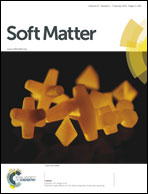Formation of supported lipid bilayers on silica: relation to lipid phase transition temperature and liposome size†
Abstract
DPPC liposomes ranging from 90 nm to 160 nm in diameter were prepared and used for studies of the formation of supported lipid membranes on silica (SiO2) at temperatures below and above the gel to liquid-crystalline phase transition temperature (Tm = 41 °C), and by applying temperature gradients through Tm. The main method was the quartz crystal microbalance with dissipation (QCM-D) technique. It was found that liposomes smaller than 100 nm spontaneously rupture on the silica surface when deposited at a temperature above Tm and at a critical surface coverage, following a well-established pathway. In contrast, DPPC liposomes larger than 160 nm do not rupture on the surface when adsorbed at 22 °C or at 50 °C. However, when liposomes of this size are first adsorbed at 22 °C and at a high enough surface coverage, after which they are subject to a constant temperature gradient up to 50 °C, they rupture and fuse to a bilayer, a process that is initiated around Tm. The results are discussed and interpreted considering a combination of effects derived from liposome–surface and liposome–liposome interactions, different softness/stiffness and shape of liposomes below and above Tm, the dynamics and thermal activation of the bilayers occurring around Tm and (for liposomes containing 33% of NaCl) osmotic pressure. These findings are valuable both for preparation of supported lipid bilayer cell membrane mimics and for designing temperature-responsive material coatings.


 Please wait while we load your content...
Please wait while we load your content...